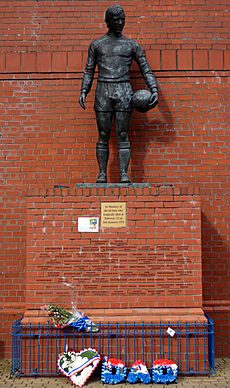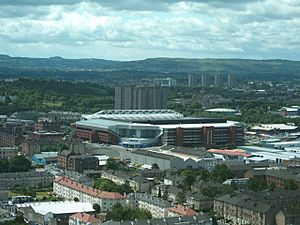1971 Ibrox disaster facts for kids

A memorial to those who died in the disaster, including a statue of then-captain John Greig, unveiled in January 2001
|
|
| Date | 2 January 1971 |
|---|---|
| Location | Ibrox Park, Glasgow, Scotland |
| Deaths | 66 |
| Non-fatal injuries | > 200 |
The 1971 Ibrox disaster was a terrible event where many people were crushed during a football game in Scotland. It happened on 2 January 1971 at Ibrox Park in Glasgow. Sixty-six people died, and more than 200 were hurt.
The game was between two big rival teams, Rangers and Celtic. This disaster was the worst football tragedy in Britain until the Bradford City stadium fire in 1985. Later, the Hillsborough disaster in 1989 caused even more deaths.
The owners of the stadium, Rangers F.C., were later found responsible for what happened. They did not argue with this decision. Many families of those who died sued the club for damages.
Contents
What Happened Before
Ibrox Stadium had seen a disaster before. In 1902, part of a wooden stand collapsed during a match between Scotland and England. That accident caused 25 deaths and over 500 injuries.
Years later, in 1963, people started worrying about the safety of Stairway 13. This stairway was near the Copland Road subway station and was a main exit. People often felt squashed on these stairs. They were sometimes lifted off their feet by the crowd and couldn't control where they were going.
There had been other accidents on Stairway 13. In 1961, two people died and many were hurt in a crush. In 1967, eight fans were injured. Then, in 1969, 26 people were hurt in another accident on the same stairway. Even though these things happened, no experts were asked to check the dangers of Stairway 13. Rangers had spent a lot of money, about £150,000, on stadium improvements by then.
The Day of the Disaster
The disaster happened on Saturday, 2 January 1971. It was an "Old Firm" game between Rangers and Celtic. More than 80,000 fans were at the stadium.
In the last minute of the game, Celtic scored, making it 1–0. But then, Rangers player Colin Stein scored an equalizing goal right at the end. As thousands of fans were leaving the stadium using Stairway 13, someone likely fell. This caused a huge pile-up of people.
At first, some thought that fans who left early when Celtic scored might have turned back when Rangers equalized. This idea suggested they crashed into other fans leaving the stadium. However, the official investigation found this was not true. All the fans were moving in the same direction when the crush happened.
Most people died because they couldn't breathe due to the pressure of the crowd. Bodies were piled up to about 1.8 meters (6 feet) deep in the area. Over 200 other fans were injured.
Kenny Dalglish, who played for Celtic at the time, was in the stands that day. He was also present at the Heysel and Hillsborough tragedies later in his career.
People Who Died
Sixty-six people died at the stadium from their injuries. All of them were under 50 years old. Most were much younger:
- 61 were under 40
- 49 were under 30
- 33 were under 20
- 1 was under 10
Many children lost their lives. Five school friends from Markinch in Fife died together: Peter Easton, Martin Paton, Mason Phillips, Brian Todd, and Douglas Morrison. Thirty-one teenagers also died, including the only female victim, Margaret Ferguson, age 18. The youngest person to die was Nigel Patrick Pickup, age 9, from Liverpool.
More than 200 people were also injured.
| Age range | Males | Females | Total |
|---|---|---|---|
| 0–9 | 1 | 0 | 1 |
| 10–19 | 31 | 1 | 32 |
| 20–29 | 16 | 0 | 16 |
| 30–39 | 12 | 0 | 12 |
| 40–49 | 5 | 0 | 5 |
| Totals | 65 | 1 | 66 |
What Happened After
The disaster made the UK government look closely at safety in sports stadiums. In February 1971, a Scottish judge named Lord Wheatley started an investigation. His findings, published in May 1972, led to the "Guide to Safety at Sports Grounds". This guide was first published in 1973 and set new safety rules for stadiums.
The 1971 disaster also led to big changes at Ibrox Stadium. The manager at the time, Willie Waddell, led a huge rebuilding project. He got ideas from the Westfalenstadion in Germany. After three years of work, most of Ibrox was replaced with modern, all-seater stands. By 1981, the stadium could hold 44,000 fans. More work in the 1990s increased the capacity to 50,000. Ibrox then became a top-rated stadium by UEFA.
A Scottish folk singer, Matt McGinn, wrote a song called "The Ibrox Disaster". It was a tribute to the people who died.
Investigation and Responsibility
An official investigation was held in Glasgow starting in February 1971. It lasted seven days. The jury was told not to suggest new safety rules for football grounds. This was because Lord Wheatley's inquiry would be looking into that.
In May 1974, a judge named Sheriff James Irvine Smith looked into a case brought by the family of one of the victims. He decided that the accident was "due to the fault and negligence of the defenders, Rangers F.C." This meant he found Rangers F.C. responsible for the death of Charles Dougan, a 31-year-old man who died from being crushed.
Sheriff Irvine Smith noted that there had been many accidents on Stairway 13 before. He said that Rangers' management "never so much as considered that it ought to apply its mind to the question of safety on that particular stairway." He felt they ignored the problem. Rangers F.C. did not argue with these findings. They only discussed how much money should be paid in damages to the families.
Remembering the Disaster
For many years after 1971, there was only a small plaque at the stadium to remember the disaster. But in 1995, Rangers announced plans for a bigger memorial.
On 2 January 2001, the 30th anniversary of the tragedy, a large monument was unveiled. It stands at a corner of the stadium. The monument has blue plaques with the names of everyone who died in all three Ibrox incidents. A statue of John Greig, who was the Rangers captain in 1971, stands on top of the monument.
In 2011, the 40th anniversary was remembered before an Old Firm game. Everyone observed a minute of silence. Both teams wore black armbands. John Greig and Billy McNeill, the captains from the time of the disaster, led the teams out onto the field.
See also
- 1902 Ibrox disaster
- Burnden Park disaster
- Luzhniki disaster
- Bradford City stadium fire
- Hillsborough disaster
- List of disasters of the United Kingdom and preceding states
- Heysel Stadium disaster



